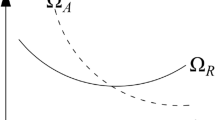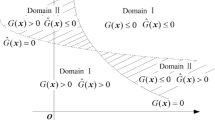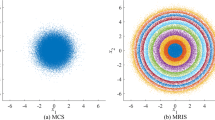Abstract
An innovative strategy of the design of experiments (DoE) is proposed to reduce the number of calls of the performance function in the kriging-based structural reliability analysis procedure. Benefitting from the local uncertainty provided by the kriging model and the joint probability density function of performance function values of untried points derived in this research, the epistemic variance of the target failure probability is calculated approximately. The variance is treated as the accuracy measurement of the estimated failure probability. The next best point is defined as the untried point that can minimize the variance of failure probability in the sense of expectation which is computed by Gauss–Hermite quadrature. The basic idea of the proposed strategy is to refresh the current DoE by adding the next best point into it. The candidate points of the next best one are randomly generated by Markov chain Monte Carlo method from the kriging-based conditional distribution. A structural reliability analysis procedure is introduced to apply the proposed DoE strategy, whose stopping criterion is constructed mainly on the basis of the coefficient of variation of failure probability. To validate the efficiency of the proposed DoE strategy, three examples are analyzed in which there are explict and implict performance function. And, the analysis results demonstrate the outperformance of the innovative strategy.







Similar content being viewed by others
References
Alibrandi U, Alani AM, Ricciardi G (2015) A new sampling strategy for SVM-based response surface for structural reliability analysis. Probab Eng Mech 41:1–12
Au S-K (2016) On MCMC algorithm for subset simulation. Probab Eng Mech 43:117–120
Au SK, Beck JL (2001) Estimation of small failure probabilities in high dimensions by subset simulation. Probab Eng Mech 16(4):263–277
Bae S, Park C, Kim NH (2018) Uncertainty quantification of reliability analysis under surrogate model uncertainty using Gaussian process. in ASME 2018 International Design Engineering Technical Conferences and Computers and Information in Engineering Conference, IDETC/CIE 2018, August 26, 2018 - August 29, 2018. American Society of Mechanical Engineers (ASME), Quebec City
Bichon BJ et al (2008) Efficient global reliability analysis for nonlinear implicit performance functions. AIAA J 46(10):2459–2468
Blatman G, Sudret B (2008) Sparse polynomial chaos expansions and adaptive stochastic finite elements using a regression approach. CR Mec 336(6):518–523
Blatman G, Sudret B (2010) An adaptive algorithm to build up sparse polynomial chaos expansions for stochastic finite element analysis. Probab Eng Mech 25(2):183–197
Bourinet JM, Deheeger F, Lemaire M (2011) Assessing small failure probabilities by combined subset simulation and support vector machines. Struct Saf 33(6):343–353
Bucher C, Most T (2008) A comparison of approximate response functions in structural reliability analysis. Probab Eng Mech 23(2–3):154–163
Cornuet JM et al (2012) Adaptive multiple importance sampling. Scand J Stat 39(4):798–812
Dubourg V, Sudret B, Deheeger F (2013) Metamodel-based importance sampling for structural reliability analysis. Probab Eng Mech 33:47–57
Echard B, Gayton N, Lemaire M (2011) AK-MCS: an active learning reliability method combining kriging and Monte Carlo simulation. Struct Saf 33(2):145–154
Echard B et al (2013) A combined importance sampling and kriging reliability method for small failure probabilities with time-demanding numerical models. Reliab Eng Syst Saf 111:232–240
Gaspar B et al (2014) System reliability analysis by Monte Carlo based method and finite element structural models. J Offshore Mech Arct Eng Trans ASME 136(3):1–09
Gayton N, Bourinet JM, Lemaire M (2003) CQ2RS: a new statistical approach to the response surface method for reliability analysis. Struct Saf 25(1):99–121
Jones DR, Schonlau M, Welch WJ (1998) Efficient global optimization of expensive black-box functions. J Glob Optim 13(4):455–492
Kaymaz I (2005) Application of kriging method to structural reliability problems. Struct Saf 27(2):133–151
Kleijnen JPC (2009) Kriging metamodeling in simulation: a review. Eur J Oper Res 192(3):707–716
Lv Z, Lu Z, Wang P (2015) A new learning function for kriging and its applications to solve reliability problems in engineering. Comput Math Appl 70(5):1182–1197
Melchers RE (1990) Radial importance sampling for structural reliability. J Eng Mech ASCE 116(1):189–203
Pradlwarter HJ et al (2007) Application of line sampling simulation method to reliability benchmark problems. Struct Saf 29(3):208–221
Richard J-F, Zhang W (2007) Efficient high-dimensional importance sampling. J Econ 141(2):1385–1411
Roussouly N, Petitjean F, Salaun M (2013) A new adaptive response surface method for reliability analysis. Probab Eng Mech 32:103–115
Schueremans L, Van Gemert D (2005) Benefit of splines and neural networks in simulation based structural reliability analysis. Struct Saf 27(3):246–261
Shimoyama K et al (2013) Updating kriging surrogate models based on the hypervolume indicator in multi-objective optimization. J Mech Des 135(9):094503
Sobol IM, Tutunnikov AV (1996) A variance reducing multiplier for Monte Carlo integrations. Math Comput Model 23(8–9):87–96
Song H et al (2013) Adaptive virtual support vector machine for reliability analysis of high-dimensional problems. Struct Multidiscip Optim 47(4):479–491
Sun Z et al (2017) LIF: a new kriging based learning function and its application to structural reliability analysis. Reliab Eng Syst Saf 157:152–165
Yang X et al (2015a) An active learning kriging model for hybrid reliability analysis with both random and interval variables. Struct Multidiscip Optim 51(5):1003–1016
Yang X et al (2015b) Hybrid reliability analysis with both random and probability-box variables. Acta Mech 226(5):1341–1357
Yu H, Gillot F, Ichchou M (2012) A polynomial chaos expansion based reliability method for linear random structures. Adv Struct Eng 15(12):2097–2111
Zhang H, Mullen RL, Muhanna RL (2010) Interval Monte Carlo methods for structural reliability. Struct Saf 32(3):183–190
Zhao YG, Ono T (1999) A general procedure for first/second-order reliability method (FORM/SORM). Struct Saf 21(2):95–112
Funding
The study was funded by National Science and Technology Major Project of China (Grant No. 2013ZX04011-011) and the National Defense Technology Foundation of China (Grant No. JSZL2015208B001).
Author information
Authors and Affiliations
Corresponding author
Ethics declarations
Conflict of Interest
The authors declared that they have no conflicts of interest to this work. We declare that we do not have any commercial or associative interest that represents a conflict of interest in connection with the work submitted.
Additional information
Responsible Editor: Raphael Haftka
Publisher’s note
Springer Nature remains neutral with regard to jurisdictional claims in published maps and institutional affiliations.
Rights and permissions
About this article
Cite this article
Yin, M., Wang, J. & Sun, Z. An innovative DoE strategy of the kriging model for structural reliability analysis. Struct Multidisc Optim 60, 2493–2509 (2019). https://doi.org/10.1007/s00158-019-02337-0
Received:
Revised:
Accepted:
Published:
Issue Date:
DOI: https://doi.org/10.1007/s00158-019-02337-0




